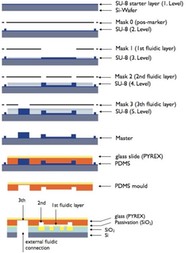The microreaction chamber systems has been produced by soft-lithography. The
main fabrication steps are as follows. A silicon wafer with multi-plane patterned photoresist
combination of SU8 serves as a mould master. For polymer moulding a solution mixture of PDMS
prepolymer and the curing agent is then cast against the master.
Curing the polymer and releasing it from the master yields a
replica containing three levels of different heights of the desired microchannels and -chambers. The
resulting PDMS moulds have favourable optical properties for fluorescence-based
detection, due to the fact that PDMS has almost no absorbance and minimal auto-fluorescence in the
range of visible wavelengths.

The clear-transparent microfluidic channel structures have been sealed by a silicon cover
(or optionally with the electronic layer of an FPFA chip containing a combinatorial array of microelectrodes).
The connection of the biochips to an external fluidic handling system was achieved via plastic capillary tubing of 18 connected high aspect ratio etching holes (0.3 mm diameter) in the silicon-layer and fixed with an adhesion technique specifically developed for plastic tubes (inner tube diameters are 200 μm).


